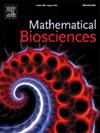冠状病毒复制-突变动力学的数学模型
IF 1.8
4区 数学
Q2 BIOLOGY
引用次数: 0
摘要
RNA病毒以其迷人的进化动力学而闻名,其特点是高突变率、快速复制和形成准物种的能力——基因相关突变体云。RNA病毒的快速复制是通过一种非常快速但容易出错的RNA依赖RNA聚合酶(RdRP)来实现的。高突变率是一把双刃剑:它们为RNA病毒提供了一种快速适应不断变化的环境或宿主免疫系统的机制,但同时它们也对病毒的生存能力构成了风险,要么是病毒种群被突变体主宰(错误突变),要么是由于突变积累而导致所有病毒序列灭绝(致命突变)。冠状病毒是RNA病毒的一个子集,其独特之处在于具有一种特殊的酶,即外核糖核酸酶(ExoN),负责校对和纠正RdRP诱导的错误。在本文中,我们考虑了冠状病毒的复制动力学,考虑了可能是中性的、有害的或致命的突变。与早期的RNA病毒复制模型相比,我们的模型还明确包括外显子及其介导病毒复制的作用。特别关注不同的病毒复制模式,这些模式对于控制病毒种群的动态至关重要。我们分析了灭绝、纯突变和准物种的稳定状态,并研究了它们在不同参数下的稳定性,确定了错误突变和致命突变的机制。由于冠状病毒是过去二十年来一些最大规模流行病的罪魁祸首,我们还模拟了使用各种复制抑制剂和诱变药物进行抗病毒治疗的效果。本文章由计算机程序翻译,如有差异,请以英文原文为准。
Mathematical model of replication–mutation dynamics in coronaviruses
RNA viruses are known for their fascinating evolutionary dynamics, characterised by high mutation rates, fast replication, and ability to form quasispecies — clouds of genetically related mutants. Fast replication in RNA viruses is achieved by a very fast but error-prone RNA-dependent RNA polymerase (RdRP). High mutation rates are a double-edged sword: they provide RNA viruses with a mechanism of fast adaptation to a changing environment or host immune system, but at the same time they pose risk to virus survivability in terms of either virus population being dominated by mutants (error catastrophe), or extinction of all viral sequences due to accumulation of mutations (lethal mutagenesis). Coronaviruses, being a subset of RNA viruses, are unique in having a special enzyme, exoribonuclease (ExoN), responsible for proofreading and correcting errors induced by the RdRP. In this paper we consider replication dynamics of coronaviruses with account for mutations that can be neutral, deleterious or lethal. Compared to earlier models of replication of RNA viruses, our model also explicitly includes ExoN and its effects on mediating viral replication. Special attention is paid to different virus replication modes that are known to be crucial for controlling the dynamics of virus populations. We analyse extinction, mutant-only and quasispecies steady states, and study their stability in terms of different parameters, identifying regimes of error catastrophe and lethal mutagenesis. With coronaviruses being responsible for some of the largest pandemics in the last twenty years, we also model the effects of antiviral treatment with various replication inhibitors and mutagenic drugs.
求助全文
通过发布文献求助,成功后即可免费获取论文全文。
去求助
来源期刊

Mathematical Biosciences
生物-生物学
CiteScore
7.50
自引率
2.30%
发文量
67
审稿时长
18 days
期刊介绍:
Mathematical Biosciences publishes work providing new concepts or new understanding of biological systems using mathematical models, or methodological articles likely to find application to multiple biological systems. Papers are expected to present a major research finding of broad significance for the biological sciences, or mathematical biology. Mathematical Biosciences welcomes original research articles, letters, reviews and perspectives.
 求助内容:
求助内容: 应助结果提醒方式:
应助结果提醒方式:


